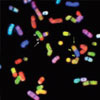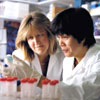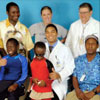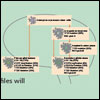Accomplishments
- Contributed key technology for the commercial development of an HPV vaccine to prevent cervical cancer
- Developed novel adoptive cell transfer therapy for metastatic melanoma
- Developed technology to classify lymphoma at molecular level
- Developed BL22 immunotoxin
- Developed monoclonal antibodies to define IL-2 receptor subunits alpha and beta
- Identified genetic mutations linked to hereditary kidney cancer
- Discovered keratinocyte growth factor
- Co-developed, co-discovered, and ran initial clinical trials for first effective AIDS drug
- Developed Spectral Karyotyping (SKY)
- Developed in vivo imaging for ovarian cancer
Making Progress
- Demonstrated proof-of-principle in animals for imaging hypoxia in tumors
- Developed monitoring technology for neurofibromatosis
- Developed automated methods for visualizing cells and viruses
- Showed that replicated adenovirus-based HIV (Ad4-HIV) and SIV vaccines elicit potent protective efficacy
- Identified and clinically evaluated first Hsp90 inhibitors
- Unraveled mechanisms of multi-drug resistance/ABC transporters
- Co-discovered interleukin-15 (IL-15) as part of an immunological synapse between dendritic cells and target NK and CD8 memory T cells
- Identified DNA repair abnormalities in rare disease Xeroderma pigmentosum (XP)
- Discovered better topo I inhibitors
- Developed translational informatics approach to glioma

Contributed key technology for the commercial development of an HPV vaccine to prevent cervical cancer
High risk - Injections of virus-like particles had to trigger a sustained immune response
High impact - A commercial HPV vaccine prevents cervical cancer

Developed novel adoptive cell transfer therapy for metastatic melanoma
High risk - Cell transfer therapy had potential for adverse immune cell effects
High impact - High frequency of response for an otherwise intractable disease

Developed technology to classify lymphoma at molecular level
High risk - Profile must be correct; guides treatment decisions
High impact- Chip enables accurate molecular diagnosis and informs treatment

Developed BL22 immunotoxin
High risk - Uncharted territory on a rare cancer with a new approach
High impact - Complete remissions in many patients with drug-resistant hairy cell leukemia

Developed monoclonal antibodies to define IL-2 receptor subunits alpha and beta
High risk - First anti-cytokine receptor monoclonal antibody; first humanized, FDA-approved antibody
High impact - FDA-approved Daclizumab reduces organ-allograft rejection, treats multiple sclerosis, and—armed with Yttrium-90—treats T-cell leukemia/lymphoma and Hodgkin's lymphoma

Identified genetic mutations linked to hereditary kidney cancer
High risk - Available technology to comb genome was labor intensive
High impact - Identifies, screens, and speeds the identification of susceptibility genes; screens families faster; improves therapy design

Discovered keratinocyte growth factor
High risk - Many hurdles; few candidate drugs obtain regulatory approval High impact - FDA-approved Kepivance reduces oral mucositis in patients receiving high-dose chemo/radiation

Co-developed, co-discovered, and ran initial clinical trials for first effective AIDS drugs
High risk - No AIDS drugs had been developed; their clinical benefit was unclear
High impact – These first AIDS drugs were the foundation for highly active antiretroviral therapy (HAART)

Developed spectral karyotyping (SKY)
High risk - Technology for studying cancer chromosomes was not reliable/reproducible
High impact - Revolutionized process of karyotyping

Developed in vivo imaging for ovarian cancer
High risk - Residual tumor after ovarian cancer surgery could not be imaged
High impact - Fluorescent imaging visualizes residual tumor in real time

Demonstrated proof-of-principle in animals for imaging hypoxia in tumors
High risk - Instrument did not exist, needed to create technology from scratch
High impact - Instrumentation detects hypoxia in vivo; has application to all solid tumors

Developed monitoring technology for neurofibromatosis
High risk - No standard treatment available for this rare cancer
High impact - Technology to measure neurofibromatosis tumors monitors efficacy of new therapies

Developed automated methods for visualizing cells and viruses
High risk - Requires visualizing at resolutions 100 times higher than light microscopy
High impact - Accelerates understanding of disease mechanisms and vaccine development

Showed that replicated adenovirus-based HIV (Ad4-HIV) and SIV vaccines elicit potent protective efficacy
High risk - HIV vaccine development has eluded scientists for 25 years
High impact - Ad4-HIV vaccine is progressing to human clinical trials

Identified and clinically evaluated first Hsp90 inhibitors
High risk - Had to validate new cancer target and understand mechanisms of activity to optimize drug development
High impact - Identification of Hsp90 as a molecular target and development of its inhibitors add to arsenal of anticancer targeted therapies

Unraveled mechanisms of multi-drug resistance/ABC transporters
High risk - No known explanation for the drug resistance common during cancer treatment
High impact - Application of discovery may lead to reversal of resistance

Co-discovered interleukin-15 (IL-15) as part of an immunological synapse between dendritic cells and target NK and CD8 memory T cells
High risk - Cytokine was undefined with no prior biological evidence for its existence
High impact - IL-15 activates NK and CD8 memory cells; is being produced for clinical use for metastatic malignant melanoma and renal cell cancer and as part of vaccine protocols

Identified DNA repair abnormalities in rare disease Xeroderma pigmentosum (XP)
High risk - Not much known about biology of XP, a rare disease
High impact - DNA repair abnormalities discovered in XP have relevance to cancer progression

Discovered better topo I inhibitors
High risk - Needed to reduce toxicity of camptothecin without reducing efficacy
High impact - Better drugs that block topoisomerase 1 are moving into clinical trials

Developed translational informatics approach to glioma
High risk - No successful standard treatment available for this brain cancer
High impact - Sharing validated markers of disease and genomic profiles will improve treatment for glioma




